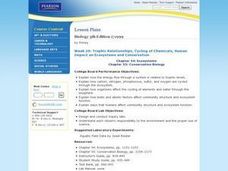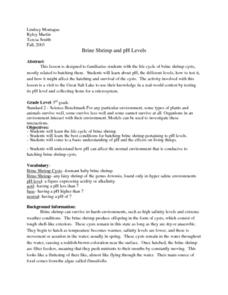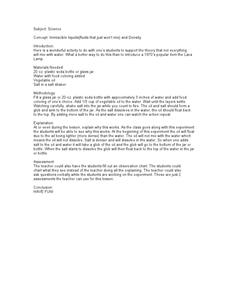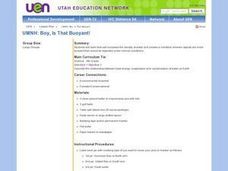Curated OER
Trophic Relationships, Cycling of Chemicals, Human Impact on Ecosystems and Conservation
Learners explore how the energy flow through a system is related to trophic levels. They investigate how organisms affect the cycling of elements and water through the biosphere. Students participate in lab activities to observe ways...
Curated OER
Rain Machine (Solar Still)
Students experiment with a solar still. In this distillation lesson, students find a simple way to use evaporation to make salty water drinkable.
Curated OER
Floating Pencil
Students discover how salt water makes a pencil float better than freshwater by measuring and comparing the lengths of the portion of the pencil that floats above the water surface. They then determine if an unknown water sample is...
Curated OER
Discovering Physical Changes
Fourth graders determine what is meant by a physical change, and they demonstrate how they can make physical changes. They complete activities at stations that entail changes in color, size, texture, hardness, or state of matter. Using...
Curated OER
Brine Shrimp And Ph Levels
Third graders investigate the different ph levels found in water that is tested using simple measurements. The water samples are taken from a local body of water. The ph levels are used to help indicate areas where shrimp can thrive in...
Curated OER
COMPARE SOILS BY GROWING PLANTS
The student will identify the difference in the rate of plant growth in three soils that vary in organic matter.1. Obtain three to four flowerpots, different types of soil, a record chart, three to five beans for each pot, and water....
Curated OER
Technology of the Deep: Experiments with Buoyant Forces
Students conduct a series of experiments to study the effects of temperature and salinity on the buoyancy of an object in water. They devise ways to make floating and sinking objects neutrally buoyant.
Curated OER
"Pandemic" A Disease Simulation
Students use small test tubes with water, salt and a silver nitrate solution to simulate the spread of infectious disease contracted the exchange of bodily fluid. They problem solve to track the original source of infection.
Curated OER
Separating Solids Experiment
In this separating solids experiment instructional activity, students follow the procedures to find what physical properties could be used to separate a mixture of pepper, salt, sand and iron filings.
Curated OER
Regions of North America: The Chesapeake Bay
In this reading comprehension worksheet, students read an article on "The Chesapeake Bay". Students read 5 sentences and fill in each blank in each sentence with a word from the article. Students answer 3 short answer questions on the...
Curated OER
Science Lesson #2
Fourth graders explore and experiment with objects that float to see if they float differently in salt water or fresh water. After the experiment, they write a paragraph in their science journal explaining how fresh water and ocean water...
Curated OER
Outcomes Science 4
In this outcome science 4 worksheet, students apply scientific knowledge to answer and calculate a variety of questions. Students research the answer to several questions using the websites suggested.
Curated OER
Chillin' Out with Freezing Point Depression
Learners examine the freezing point depression of salt water by making ice cream. Lab activity begins with students layering a bowl with ice and salt around an empty cup before adding a mystery solution to the cup. They take the...
Curated OER
Why is the Sea Salty?
Students conduct a hands-on activity to investigate salt concentrations in water and how salt remain after water evaporates. They can also do a Saltwater Painting to once again observe the evaporation. process.
Curated OER
United Kingdom
Students investigate the geographical features of the United Kingdom. They create a clay, playdoh, or salt and flour map of the region. The maps should be labeled with landmarks and bodies of water. They can also draw maps on paper for...
Curated OER
Understanding Salinity
Students discuss why the ocean is salty. They discuss what salinity is. Students are told that is they want to know how much salt is in a body or water, they would use a special scientific tool. They complete an Estuarine Layers science...
Curated OER
Immiscible Liquids and Density
Students will make a lava lamp. In this density lesson, students will combine water and oil and make observations, then add salt to the oil and observe the oil sink, then float again when the salt dissolves in the water.
Curated OER
Boy, Is That Buoyant!
Fourth graders see that salt increases the density of water and creates a condition wherein objects are more buoyant than would be expected under normal conditions. They describe the relationship between heat energy, evaporation and...
Curated OER
Influence of the World's Ocean Currents on the Carbon C
Students, in groups, observe how the salt content and temperature of water affects the ocean currents. They also read articles and dicuss.
Curated OER
Sink or Float Experiment
Students participate in an experiment to determine which objects float or sink. They use different amounts of salt for the objects and discover as the salt content increases, objects will float. They record their predictions and what...
Curated OER
Frozen Solids
Students investigate various properties of ice including melting points and the effect of pressure on ice. They demonstrate how increased pressure lowers the melting point of ice and perform a simple experiment proving that water is more...
Curated OER
Learning Lesson: That Sinking Feeling
Students discover the origin of the Great Ocean Conveyor. They participate in a demonstration showing how salinity and temperature affect water density. They also examine the new sea ice that forms every winter.
Curated OER
A Salty Experiment
Students study salty and fresh waters. In this harbor estuary lesson plan students complete a lab activity on salinity and describe what happened.
Curated OER
PIZZA PARTS
Students will measure the ingredients to make pizza dough and determine basic fractions to cut pizza.Discuss where the different ingredients come from as you follow the instructions below to put the pizza together (flour from wheat,...

























